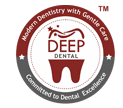Fluoride: Nature’s Cavity Fighter
Fluoride is a mineral that occurs naturally in all water sources, even the oceans. The fluoride ion comes from the element fluorine. Fluorine, the 17th most abundant element in the earth’s crust, is never encountered in its free state in nature. It exists only in combination with other elements as a fluoride compound.
Fluoride is effective in preventing and reversing the early signs of dental caries (tooth decay). Researchers have shown that there are several ways through which fluoride achieves its decay- preventive effects. It makes the tooth structure stronger, so teeth are more resistant to acid attacks. Acid is formed when the bacteria in plaque break down sugars and carbohydrates from the diet. Repeated acid attacks break down the tooth, which causes cavities. Fluoride also acts to repair, or remineralize, areas in which acid attacks have already begun. The remineralization effect of fluoride is important because it reverses the early decay process as well as creating a tooth surface that is more resistant to decay. Fluoride is obtained in two forms: topical and systemic. Topical fluorides strengthen teeth already present in the mouth making them more decay-resistant. Topical fluorides include toothpastes, mouth rinses and professionally applied fluoride therapies.


Systemic fluorides are those that are ingested into the body and become incorporated into forming oth structures. Systemic fluorides can also give topical protection because fluoride is present in saliva, which continually bathes the teeth. Systemic fluorides include water fluoridation or dietary fluoride supplements in the form of tablets, drops or lozenges.
It is important to note that the effective prevention of dental decay requires that the proper mix of both forms of fluoride (topical and systemic) made available to individuals. Your dentist can help you assess whether you are receiving adequate levels of fluoride for all family members from the two forms (topical and systemic)
Topical Fluorides
Self-Applied
One method of self-applied topical fluoride that is responsible for a significant drop in the level of cavities since 1960 is use of fluoride-containing toothpaste.
Other sources of self-applied fluoride are mouth rinses designed to be rinsed and spit out, either prescribed by your dentist or an over-the-counter variety. Deep Dental recommends the use of fluoride mouth rinses, but not for children under six years of age because they may swallow the rinse.
Professionally applied:
Professionally applied fluorides are in the form of gel, foam or rinse are applied by dentist or dental hygienist during dental visits. These fluorides are more concentrated than the self-applied fluorides, and therefore are not needed as frequently. Deep Dental recommends that dental professionals use any of the professional strength, tray-applied gels or foam products.
Facts about fluoride
Cavities used to be a fact of life. But over the past few decades, tooth decay has been reduced dramatically. The key reason: fluoride.
Research has shown that fluoride reduces cavities in both children and adults. It also helps repair the early stages of tooth decay even before the decay becomes visible. Unfortunately, many people continue to be misinformed about fluoride and fluoridation. Fluoride is like any other nutrient, its is safe and effective when used appropriately. This article will help you learn more about the important oral health benefits of fluoride.

